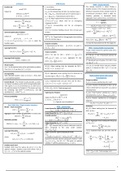Summary
Summary HR-analytics
- Course
- Institution
Summary of the HR-analytics course 2020. Almost all literature is included: Edwards & Edwards Chapter: 1, 2, 3 & 4, Khan & Millner Chapter: 1, 2, 5, 6, 7, 10, Cascio Chapter: 1 & 2, Chamorro=Premuzic et al., Angrave et al., Rasmussen & Ulrich, Van den Heuvel et al., Levenson & Flink and Peeters et ...
[Show more]








